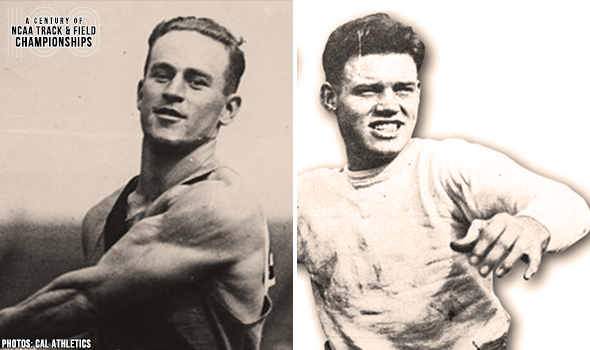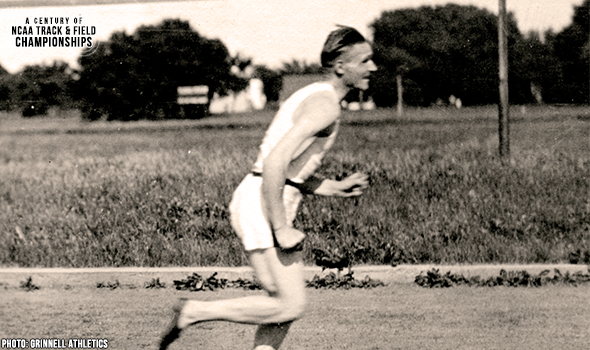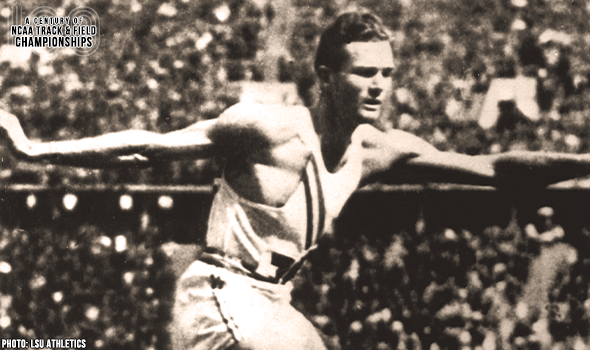
Merchant, Muller Led Cal’s Field Day In 1922
Cal had a literal field day in 1922.
As great as the inaugural NCAA Outdoor Track & Field Championships were in 1921, the second event was bigger — and arguably, even better.
The 1922 edition had something the 1921 version didn’t – the California Golden Bears, hot off a second-straight win at the powerful IC4A Championships (Cal was the first non-East Coast program to win the meet in 1921).
The Bears scored all but three of their then-record 281⁄18 points in all seven field events (The triple jump was not yet on the program and would only be held five times between 1932 and 1956, before becoming an annual event in 1959). They were led by a pair of three-event scorers – both in combinations that displayed exceptional and unusual athletic ability.
Jack Merchant – a 1920 Olympian in the long jump – won NCAA titles in the shot and hammer, the latter being the event in which he would compete at the 1924 Olympics. He added points in the long jump, placing fourth when all field events were contested on the same day.
Merchant, who was a graduate of the same Marshfield High School in Coos Bay, Oregon (formerly known as Marshfield, Oregon) as eventual distance legend Steve Prefontaine, scored a team-high 11 points at the 1922 NCAA meet. To wit, scoring was on a 5-3-2-1-½ system back then; Merchant’s performance would be worth 25 points on the current scoring system, a meet total that wouldn’t be surpassed until Jesse Owens racked up 40 in back-to-back years in 1935 and 1936.
Cal’s other point-scoring machine was Harold “Brick” Muller (He was commonly called “Brick” because of the red color of his hair). Born near the Oregon border in Dunsmuir, California, Muller grew up in San Diego and went to Cal as a football player (He was MVP for the Bears’ “Wonder Team” in their 28-0 win over Ohio State in the 1921 Rose Bowl).
Muller was as versatile as Merchant in track & field — and actually more accomplished internationally, earning the silver medal at the 1920 Olympics in the high jump. In the 1922 NCAA meet, Muller’s best finish was in the long jump where he took second over Merchant’s aforementioned fourth. Muller also added points in the high jump (third) and discus (fourth).
After playing and coaching football – notably at the same time for the Los Angeles Buccaneers in their only season in the NFL in 1926 – Muller would also go to a second Olympics, but not until 1956 as head team physician.
Cal nearly won that 1922 NCAA meet just with Merchant and Muller. After all, runner-up Penn State’s 19½ points were the only total higher than the 17 combined points from the Bear duo. Cal also had five more scorers in the meet to turn away the Nittany Lions: Allen Norris tied for first in the pole vault; Harry McDonald finished second in the 440 as the team’s only scorer on the track; Jack Witter took third in the shot; Sandy Sorrenti was third in the javelin; Ted Treyer ended up in a nine-way tie for fifth in the high jump, which helps explain the fractions.
The NCAA and collegiate track & field will mark a momentous milestone in the spring of 2021 -- the 100th anniversary of the NCAA Championships and with that, the NCAA Track & Field Championships. In June 1921, the University of Chicago hosted the first track & field championships in NCAA history.
This point can’t be emphasized enough: Not only was the event the first for NCAA track & field, but the first championships for any sport under the sponsorship of the NCAA.
To celebrate, over each of the next 365 days, the U.S. Track & Field and Cross Country Coaches Association (USTFCCCA) will celebrate moments, student-athletes, and coaches that have made a century’s worth of championships special. From humble beginnings to important historical milestones to the modern-day, collegiate track & field has evolved with the American society.
The 2021 edition of the NCAA Division I Outdoor Track & Field Championships begin with preliminary round action on May 27-29 in Jacksonville, Fla., and College Station, Texas. The championships final site and culmination of the celebration is slated for June 9-12, 2021 at the newly rebuilt Hayward Field in Eugene, Ore.

SIU’s Roggy Dominated The Javelin In 1978
Bob Roggy won the javelin title at the 1978 NCAA DI Outdoor T&F Championships by more than 20 feet. Roggy qualified first for the final with a MR heave of 89.30m (293‑0).

Makusha Made History In Bowerman Year Of 2011
Ngoni Makusha became just the fourth man in meet history to win individual titles in both the 100 and LJ. It was his 3rd career LJ crown and he set a CR in the 100 of 9.89.

George Mason’s Gage Shocked The NCAA LJ In 1988
Nena Gage won the long jump at the 1988 NCAA DI Outdoor T&F Championships in a shocking upset over Gail Devers.

Texas’ Thompson Marveled In NCAA Distance Events
Jerry Thompson won three career distance titles at the NCAA Outdoor T&F Championships. His first came in 1943. Then he won again in 1947 & 1948 after serving in World War II.

Grinnell’s Paulu Sprinted To NCAA History
Leonard Paulu was the first athlete to complete the 100-200 double in NCAA Outdoor Track & Field Championships history in 1922. That also made him the 1st to win back-to-back 100 titles, too.

Scott Won Back-To-Back NCAA Hammer Titles
Candice Scott won back-to-back hammer throw titles at the NCAA DI Outdoor T&F Championships in 2003 & 2004. Scott set a meet record of 69.77m (228-11) in that first year.

Drouin Soared To The Bowerman In 2013
Derek Drouin won two career HJ titles at the NCAA DI Outdoor T&F Championships. When Drouin won in 2013, he was only the fourth man to clear 2.34m (7-8) in meet history.

Watts Made Quick Work Of NCAA 400
Quincy Watts set a meet record in the 400 of 44.00 at the 1992 NCAA DI Outdoor Track & Field Championships. It lasted 25 years until 2017.

Iowa State’s Koll Rolled To 5K-10K Crowns
Lisa Koll won three career titles at the NCAA DI Outdoor T&F Championships in dominant fashion. Her average margin of victory in those 5K & 10K races was 37.73 seconds.

LSU’s Hardin Completed Unique 440-220H Double Twice
The nearly unheard of 440-220H double was so nice that Glenn Hardin did it twice! Hardin became the first to do so in meet history in 1933 and then swept them again in 1934.

